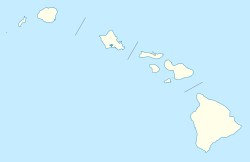Kapapa Island facts for kids
Quick facts for kids |
|
|
Kapapa Island
|
|
| Location | Kāne'ohe Bay, O'ahu |
|---|---|
| Area | 7 acres |
| NRHP reference No. | 72000430 |
| Added to NRHP | August 21, 1972 |
Kapapa Island is a small, flat island in the beautiful Kāneʻohe Bay off the coast of O'ahu, one of Hawaii's main islands. It's not very big, only about 7 acres, and no one lives there permanently. Even though it's small, Kapapa Island has a rich history and is an important place for wildlife.
Contents
A Special Place in History
Kapapa Island holds a special place in the history of Hawaii. Long ago, the Ancient Hawaiians used this island as a sacred place for worship.
Ancient Hawaiian Worship
On Kapapa Island, you can find the remains of a heiau. A heiau was a special stone structure or temple used by Ancient Hawaiians for religious ceremonies. These ceremonies were very important to their way of life.
National Register of Historic Places
Because of its historical importance, Kapapa Island was recognized as a significant site. It was added to the National Register of Historic Places as the Kapapa Island Complex and Historic District. This means it's officially protected as a place that tells us about the past.
Protecting Kapapa Island
Kapapa Island is not just important for its history; it's also a safe home for many animals and plants. Because of this, efforts have been made to protect its natural resources for a long time.
Early Protection Efforts
The protection of Kapapa Island's wildlife began way back in 1917. People realized how special the island's plants and animals were and wanted to keep them safe.
Becoming a Wildlife Sanctuary
In 1932, an official order was made to protect the island as a wildlife reservation. This was a big step towards keeping its natural environment healthy. Later, in 2010, the Department of Land and Natural Resources announced even stronger protection. Kapapa Island is now officially a wildlife sanctuary, which means its wildlife and natural habitats are carefully protected by rules. This helps ensure that the island remains a safe haven for future generations of animals and plants.


